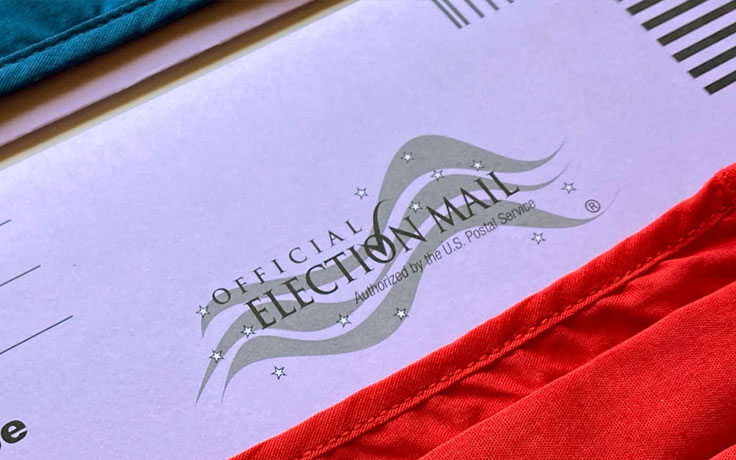EARLY IN HIS RESEARCH on how the Internet influences public understanding of science, a friend sent Aaron Panofsky a link to Stormfront, the largest white nationalist website on the Internet. It became essential as an entree into how white supremacists were sharing results of their genetic ancestry tests. Some were not as white as they had thought.
Panofsky, a UCLA sociologist, and his colleagues Joan Donovan, now at Harvard, and postdoctoral fellows Kushan Dasgupta and Nicole Iturriaga had won a National Science Foundation grant to explore how non-scientists make sense of scientific discussions on the Internet. On Stormfront, Panofsky and his team followed lengthy and sometimes heated debates.
Some of the debates were about whether a white man should date a woman with Native American ancestry. Others were about how Stormfront devotees could explain why they were not as European as they would like to be. “As we studied these threads of discussion,” Panofsky said in a recent interview, “Donald Trump announced his candidacy.
“And white nationalist groups mobilized.”
On August 12, 2017, hundreds of self-identified white supremacists, anti-Semites and other far-right extremists battled counter-protesters at a “Unite the Right” rally in Charlottesville, Virginia. The melee led to three deaths and more than 30 injuries.
Two days later, Panofsky reported on his research to an annual meeting of the American Sociological Association. Stormfront followers had not been simply chewing over their ancestry, he told his colleagues. They were using scientific language to construct alternative narratives about racial identity and, in the process, delegitimizing scientific expertise on other issues like childhood vaccines and the COVID pandemic.
As he left the stage, Panofsky said, his cellphone “blew up” with interview requests, and news accounts of his findings appeared in mainstream media across the country.
In the wake of the January 6 Capitol insurrection, Panofsky’s findings, and those of other social scientists, hold new implications for how to curb violent, extremist groups. The explosive growth and brazenness of these groups in recent years and the threat they pose to democracy have pushed combatting the rise of domestic terrorists to the forefront of the national policy agenda. Moreover, those groups will not exit the stage with President Trump. The 2020 election ended the tenure of a leader they admired, but white supremacists were heavily involved in the Capitol insurrection and remain a part of the American political landscape – on the fringe, to be sure, but a clear threat.
Restoring consensus and trust in expertise and government institutions will be slow and difficult. It will require stepped up enforcement of existing laws and policies aimed at domestic terrorists, as President Joseph Biden now promises. It may also require new legislation, and hardest of all, it will involve engaging those most vulnerable to far-right ideologies before they tumble into the Internet’s darkest corners.
“Looking white”
As part of their research, Panofsky, Donovan, Dasgupta and Iturriaga and a team of UCLA undergraduate and graduate students searched every conversation about genetic tests on the Stormfront website, posted over a decade starting in the mid- 2000s. These discussions most often arose after posters took commercially available genetic tests, like 23andMe, and discovered they were not as “white” as they had believed or hoped.
Those revelations sometimes prompted Stormfront followers to insult and discredit users they deemed “non-white.” More often, however, Panofsky and his colleague found that these often-anguished conversations focused on what Panofsky calls “repairing” unwelcome results by discrediting the genetic tests as the products of a Jewish multicultural conspiracy, suggesting widespread statistical or technical errors in the tests, and urging posters to trust their physical appearance and racial self-identify.
Typical are these replies from Stormfront posters to revelations from other posters about their disappointing genetic results (with spelling and punctuation as written).
- Most WN’s [white nationalists] do not hold to a ‘one-drop’ rule. If you look White, live White, identify White, if your grand-parents and great-grand-parents looked White/lived White/identified White – that is often sufficient….
- The only trustworthy way to find your ancestors is geneaology. Most of the time those DNA ancestry tests are out to prove that race does not exist and we are never “full white” just because a half evolved ancestor of ours resided in a non-european area, and because of that they claim that we are all racially diverse….
Panofsky says these often-tortured rationales are “judo moves against the scientific community” with Stormfront posters “interpreting themselves as Galileo.” Their aim, he said, “is to establish themselves as dissident scientific martyrs against elites captured by political correctness.”
A history of hatred
The mob that vandalized the Capitol is the direct descendant of a long line of organized, right-wing hate groups in this country, including the Ku Klux Klan, which was founded at the end of the Civil War and used violence and intimidation to block African Americans from exercising their newly won civil rights. The Klan still exists, but its strength and influence have been dwarfed by a recent explosion of other white nationalist and nativist groups, self-proclaimed militias, religious extremists and conspiracy-soaked QAnon followers.
A series of violent incidents during the 1990s amplified the message and increased the ranks of these groups, including standoffs between armed religious fundamentalists and federal agents at Ruby Ridge, Idaho, and Waco, Texas, and the bombing of the Oklahoma City federal building in 1995. More recently, white supremacists carried out deadly rampages in Charleston, South Carolina; Pittsburgh, Pennsylvania; and El Paso, Texas.
The 2015 murder of nine African American worshippers inside a Charleston church by a 21-year old white supremacist may have been a “turning point,” said Shirin Sinnar, a Stanford Law School professor who studies terrorism and national security.
The FBI has long had legal authority to investigate right-wing terrorists and broad power to charge and prosecute them, Sinnar said in an interview, but the agency has not taken those threats seriously enough. Instead, she said, it has paid “lopsided attention” to the activities of left-leaning groups.
Nonetheless, in 2017, the FBI and the Department of Homeland Security identified white supremacists as the deadliest domestic terrorist threat to the United States. The agencies reviewed “lethal and potentially lethal incidents” of white supremacist violence from 2000 to 2016, noting that “the often spontaneous and opportunistic nature of these acts that limits prevention by law enforcement.
“It’s possible that the FBI is devoting more attention now than in the past,” Sinnar said, “but we don’t really know.”
What is clear is that the threat has grown.
While the number of hate groups declined last year, according to the Southern Poverty Law Center’s annual census, the proliferation of extremist platforms has allowed individuals to engage with followers of QAnon or Boogaloo without being card-carrying members. The result is a broader but more loosely affiliated movement of far-right extremists.
In addition, the threat of violence posed by these extremists has escalated. A report from the Center for Strategic and International Studies, a Washington-based think tank, found that right-wing extremists, in contrast to those on the left, were responsible for two-thirds of the violent attacks and plots in the United States in 2019 and more than 90 percent during the first half of 2020 alone. Writing in June of last year, CSIS researchers were especially – and it turned out, correctly – worried about violence around the November 2020 election.
In nearly half of the more than 200 federal cases filed in the weeks after the Jan. 6 riot, authorities cited evidence that conspiracy theories or extremist ideologies inspired the insurrectionists, according to an Associated Press review of court records.
Moreover, many experts fear the Capitol attack will further embolden supporters of violent groups like the Proud Boys and the Oath Keepers, rather than give them pause. While membership figures are hard to come by for these groups, many of which exist largely on the Internet, a bulletin issued in January by federal law enforcement agencies warned that the insurrection may well galvanize anti-government militias and extremist groups, swell their ranks, and “very likely pose the greatest domestic terrorism threats in 2021” and beyond.
Election lies and murder
Panofsky, 46, who joined UCLA in 2008 and now splits his time between the Luskin School and UCLA’s Institute for Society and Genetics, struggles with how to respond to this growing threat.
“That’s one of my embarrassments about being in a policy school,” he said. “Sometimes I just wish I had a five-step program I could trot out for people.”
Panofsky is most surprised at the power of “ideology and repeated lies about the election that can move people to murderous actions.” He believes that countering these false narratives – anddefusing extremist groups – will require a multifaceted, deliberative approach.
Start by doing more to root out extremist views among military and law enforcement personnel, says Heather Williams at the RAND Corporation. Her research specialties include civil-military relations and counterterrorism.
Supremacy and the military
Nearly 1 in 5 of the Capitol rioters charged by mid-February have a history of military service. At least one carried a Marine Corps flag. Others displayed Army and Special Forces insignias on their clothing.
The Army bars its members from joining extremist groups or participating in extremist activity, the toughest standard in the military. The Defense Department is considering holding all service members to that standard and paying more attention to their social media postings.
Biden’s defense secretary, Lloyd Austin, has told military leaders to hold a one-day stand down from other duties to address extremism within the ranks. Officers and supervisors at all levels, he said, must focus on “the importance of our oath of office; a description of impermissible behaviors; and procedures for reporting suspected, or actual, extremist behaviors.”
Like the military, police forces may need a stand-down. Some anti-government militias, The New Yorker reported this spring, “who are now among groups being investigated for planning the Capitol attack, make a special point of recruiting members from law enforcement.”
Williams supports improvements. “Certainly,” she said, “some patching needs to be done.”
Shortly after his inauguration, Biden directed law enforcement and intelligence officials to study the threat of violent extremism in the United States with an eye toward possible new legislative proposals, another signal of a more concerted focus on the risk at home.
However, Williams at RAND and Sinnar at Stanford also urge caution. Applying laws aimed at foreign terrorists to domestic extremists may not be a good fit and could be used to stifle dissent, especially by people of color and other marginalized groups.
Interrupting the spread of disinformation may be more effective, Williams said.
In the week following actions on Jan. 8 by Twitter, Facebook and other mainstream social media to ban Trump and some of his key allies from their sites, postings about election fraud plunged 73 percent, according to a study by Zignal Labs, a San-Francisco-based analytics firm.
Williams was not surprised.
“What appeals to people who are engaged in these platforms is that people are listening to them,” she said, “but I don’t think there is a lot [of] glue.”
Panofsky agrees, but he says his Stormfront research argues for a more pro-active approach to how we talk about science, especially around genetics and race.
People on the left often describe race as a social construct and focus on a history of racism, politics and injustice, he said. But as scientists have identified genetically influenced traits that differ amongracial groups, “that leaves an opening for white nationalists who overemphasize and reify those biological correlations in a way that makes it seem like science informs their position.”
Panofsky sees promise in efforts to develop tools and resources to arm people before they are seduced by racist ideologies. He cites ongoing curriculum reforms designed to help high school students understand human differences in more socially responsible ways.
Love heals
In the end, however, he believes that more people leave radical groups through love than out of shame or punishment.
He points to Derek Black, now 31, son of Don Black, the founder of Stormfront.
Derek grew up steeped in his family’s militantly white nationalist beliefs. However, after earnest and wide-ranging study in college and long dinner discussions with Jewish, African American, Muslim and LGBT students, these people he was taught to hate became his friends.
Derek ultimately renounced his white racist views.
“I can’t support a movement that tells me I can’t be a friend to whomever I wish,” he wrote in a 2013 online post, “or that other people’s races require me to think of them in a certain way or be suspicious at their advancements.”
His change of heart was slow and painful, and it caused a rift in his family, especially with his father.
For Panofsky, Derek Black’s evolution attests to the power of a liberal arts education and of tolerance and acceptance.
“It’s a beautiful and amazing story,” Panofsky said.
It gives him hope.

























